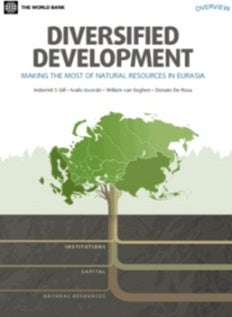Last week, the World Bank's Europe & Central Asia region published Diversified Development, a highly readable report written by Indermitt Gill, Ivailo Izvorski, Willem van Eeghen, and Donato De Rosa. The subtitle, making the most of natural resources in Eurasia, indicates that the report focuses on countries that are currently highly specialized as a result of their comparative advantage in natural resources. It addresses the question to what extent these countries have to diversify to ensure long-term prosperity. Clearer than ever before, the authors show that that is the wrong question to ask. That question gets the causality backwards. A diversified economy can result from successful development, but forced diversification is unlikely to lead to successful development.
 The report contains a beautiful description of California’s development. California is currently one of the most diversified economies in the world, with a blossoming tourism industry, a successful agricultural sector, a leading high-tech sector in Sillicon Valley—triggered by topnotch universities—and Hollywood’s dominating entertainment sector. That same California was in early 20th century, after oil was found, “the original petro-state” (and even before that it was a typical natural-resource economy, characterized by the gold rush in the middle of the 19th century). The development from an economy specialized in natural resources to a completely diversified one was not caused by favoring new industries and forcing diversification. It was the natural result of accumulating assets beyond the natural resources. Migrants moved to California, revenues were invested, schools and universities were created and strong institutions were established. As these assets were accumulated, comparative advantages started to change and other sectors became increasingly competitive.
The report contains a beautiful description of California’s development. California is currently one of the most diversified economies in the world, with a blossoming tourism industry, a successful agricultural sector, a leading high-tech sector in Sillicon Valley—triggered by topnotch universities—and Hollywood’s dominating entertainment sector. That same California was in early 20th century, after oil was found, “the original petro-state” (and even before that it was a typical natural-resource economy, characterized by the gold rush in the middle of the 19th century). The development from an economy specialized in natural resources to a completely diversified one was not caused by favoring new industries and forcing diversification. It was the natural result of accumulating assets beyond the natural resources. Migrants moved to California, revenues were invested, schools and universities were created and strong institutions were established. As these assets were accumulated, comparative advantages started to change and other sectors became increasingly competitive.
That means for Eurasian economies, they should use the revenues from natural resources to build up infrastructure, advance education, and improve institutions. That will lead to successful development and ultimately to a more diversified economy. Trying to force diversification without accumulating these other assets will ultimately prove to be an unsuccessful strategy.
The policy advice originating from this focus on natural development can be summarized as: go with the flow. Use and facilitate the natural opportunities for development. There is a reason why cities develop along big rivers. Governments might want to canalize the rivers or regulate the water flow, but they should not force development in water-scarce areas. There is a reason why financial sectors develop in ports (New York, London, Singapore, and Shanghai). International trade requires complicated financial support. Governments might want to regulate the financial sector, but they will not be successful if they try to force a different sectoral structure onto those international gateways.
So far, so good. Countries with natural resources are not that different from countries with abundant labor or from capital-rich countries. In all cases successful development cannot go against the comparative advantages that are determined by the endowments. However, the example of California and the association with water makes you remember one of the best movies ever: Chinatown. It showed the harm done when people try to capture rents through monopoly over California’s water supply. That monopoly power over natural resources can easily lead to corruption with all its consequences. That is why Diversified Development puts so much emphasis on the right institutions. In countries with natural resources the right institutions are even more important than in other countries and even more important than high levels of education or sophisticated infrastructure.


Join the Conversation